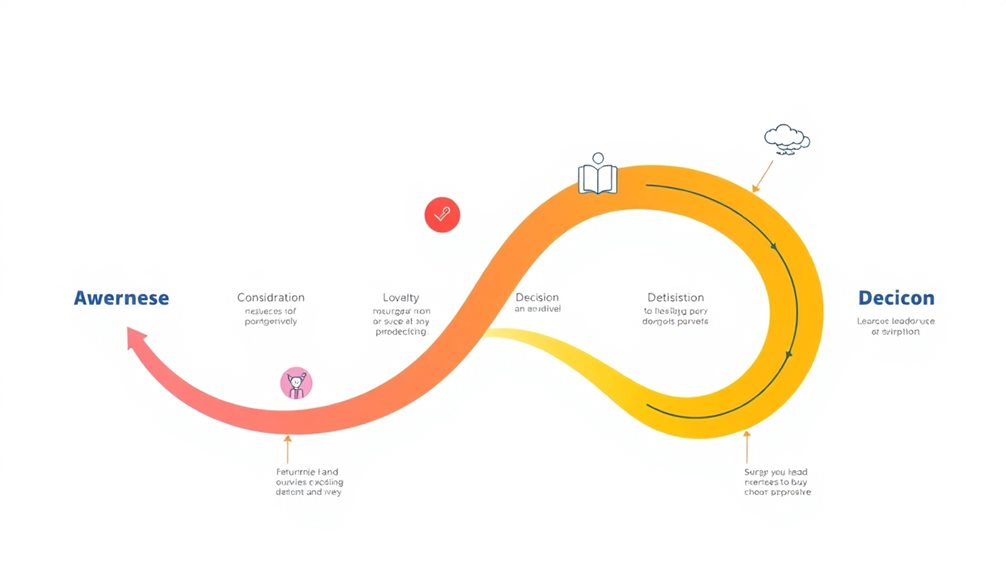You can greatly boost your understanding of consumer behavior by using AI technologies to gather real-time insights. Start by leveraging Natural Language Processing to analyze consumer-generated text and sentiment. Implement predictive analytics to forecast future behaviors based on historical data. Enhance data collection methods with AI-driven surveys and social media monitoring. Automate insights generation to identify trends swiftly and improve decision-making. Finally, address ethical considerations by ensuring data privacy and transparency. These strategies will transform how you engage with your audience. Explore further strategies and approaches to optimize your consumer behavior insights even more.
Key Takeaways
- Utilize Natural Language Processing (NLP) to analyze consumer-generated text for real-time sentiment insights and emerging trends.
- Implement predictive analytics to forecast future consumer behaviors and enhance customer segmentation based on historical data.
- Enhance data collection methods with AI tools that adapt surveys in real-time and automate feedback through chatbots.
- Automate insights generation to quickly identify trends, reducing analysis time from weeks to hours for immediate action.
- Address ethical considerations by ensuring data privacy, transparency in AI algorithms, and obtaining informed consent from consumers.
Leveraging Natural Language Processing

In today's fast-paced digital landscape, leveraging Natural Language Processing (NLP) can give you a significant edge in understanding consumer behavior. By using AI-driven NLP, you can analyze large volumes of consumer-generated text, like social media posts and reviews, to extract real-time insights about preferences and sentiments. This capability allows you to gauge consumer sentiment effectively and react quickly to shifts in emotional responses.
Sentiment analysis, a key component of NLP, quantifies consumer opinions, providing you with actionable insights into public perception. Instead of manually sifting through extensive customer feedback, NLP techniques can summarize this data, helping you identify common themes and urgent issues. This means you can stay attuned to what your customers are saying without the overwhelming workload.
Furthermore, employing NLP algorithms allows you to track emerging trends and keywords, keeping you ahead of evolving consumer interests. By understanding these trends and patterns, you can adjust your marketing strategies, tailoring your messaging and offerings based on current consumer sentiment and discussions.
This proactive approach enhances customer engagement, ensuring your brand resonates with its audience in real-time.
Implementing Predictive Analytics

Predictive analytics empowers businesses to stay ahead of consumer trends by utilizing historical data to forecast future behaviors. This approach is essential as AI greatly enhances cybersecurity measures and creates a more secure environment for managing consumer data.
By leveraging machine learning algorithms, you can identify patterns in consumer behavior, enabling real-time adjustments to your marketing strategies. This proactive approach allows you to anticipate customer needs and preferences effectively.
Here are three key benefits of implementing predictive analytics:
- Enhanced Customer Segmentation: By predicting Customer Lifetime Value (CLV), you can target high-value segments more efficiently, leading to better marketing outcomes.
- Optimized Inventory Management: Predictive analytics helps you accurately forecast demand, reducing excess stock and ensuring you meet customer expectations without over-committing resources.
- Actionable Insights: Tools like Insight7 analyze vast amounts of customer data in real time, providing you with insights that help you address concerns and improve satisfaction proactively.
Incorporating predictive analytics into your business strategy not only streamlines your operations but also positions you to adapt to evolving consumer trends, ensuring you remain competitive in the marketplace.
Embrace this technology to harness its full potential!
Enhancing Data Collection Methods

Often, businesses struggle to gather meaningful consumer data effectively. However, AI tools can greatly enhance your data collection methods, providing better consumer insights. For instance, AI-driven surveys can adapt questions in real-time based on respondents' answers, ensuring you're focused on relevant consumer interests. This adaptability allows for more accurate data analysis.
Additionally, understanding consumer behavior is vital as credit cards play a considerable role in personal finance stability, making it essential to analyze spending patterns and preferences credit card insights.
Social media data is another goldmine. By utilizing media listening tools, you can analyze conversations and customer sentiment on platforms like Twitter and Facebook. This gives you immediate insights into consumer opinions and trends. Additionally, online behavior tracking technologies can monitor user interactions across websites, helping you collect data on preferences and habits.
Furthermore, AI can automate the collection of qualitative feedback through chatbots. These interactive platforms enable rapid gathering of consumer insights without the need for manual intervention. Tools like Voxpopme even let you generate video-based surveys, capturing authentic consumer responses in real-time, enriching your data's depth.
Automating Insights Generation

Automating insights generation revolutionizes how businesses understand consumer behavior. By leveraging AI, you can analyze large datasets in real-time, identifying trends and patterns with remarkable speed and accuracy.
This technology not only enhances your decision-making capabilities but also allows for swift adjustments to marketing strategies based on actionable insights. As organizations increasingly prioritize innovative approaches to leadership, utilizing AI for insights will become a cornerstone of effective strategy development.
Here are three ways automating insights generation can benefit your business:
- Real-Time Data Processing: AI tools can reduce the time to generate insights from weeks to mere hours, allowing you to act quickly on consumer feedback.
- Sentiment Analysis: AI-driven tools can assess customer sentiment across social media and online platforms, giving you immediate updates on how your audience feels about your brand.
- Qualitative Data Analysis: Platforms like Insight7 and Salesforce Einstein enable you to transcribe and analyze customer interactions almost instantly, uncovering valuable insights from qualitative data.
Addressing Ethical Considerations

As businesses harness AI to gain insights into consumer behavior, it's important to address the ethical considerations that come with this powerful technology.
First and foremost, you need to prioritize data privacy by implementing secure AI solutions that protect consumer insights and prevent unauthorized access. Transparency is essential, so make sure you explain how your AI algorithms use data and derive insights, which helps maintain consumer trust and aligns with regulations like GDPR.
Establishing a framework for validation and verification of AI-generated insights is critical. Inaccuracies or hallucinations in outputs can mislead your understanding of consumer behavior.
Continuous monitoring of your AI systems is necessary to detect and address any potential biases in data interpretation, guaranteeing your insights reflect a complete and fair perspective.
Moreover, it's important to obtain informed consent from consumers before collecting and analyzing their data. This practice not only reinforces ethical considerations but also fosters a sense of agency among users regarding their personal information.
Frequently Asked Questions
How to Use AI for Customer Insights?
To use AI for customer insights, you can analyze feedback, monitor sentiment, and identify behavior patterns. Leverage tools that provide actionable data, enabling you to tailor strategies, enhance experiences, and improve customer engagement effectively.
How to Use AI to Predict Customer Behavior?
Imagine having a crystal ball! You can use AI to analyze historical data, spot patterns, and predict customer behavior. It helps you tailor marketing strategies and proactively address customer needs before they even arise.
What Is the Role of AI in Consumer Behavior?
AI plays an essential role in understanding consumer behavior by analyzing data, predicting trends, and gauging sentiments. You can leverage these insights to tailor your strategies, improving engagement and meeting your customers' evolving needs effectively.
How Does Artificial Intelligence Affect Consumer Insights?
How can AI transform your understanding of consumer insights? By analyzing vast data, it reveals trends and sentiments, helping you adapt quickly to preferences and enhance strategies, ensuring you stay ahead in a competitive market.
Conclusion
As you explore these five ways to harness AI for real-time consumer behavior insights, remember that 72% of consumers now expect personalized experiences based on their preferences. By leveraging natural language processing, predictive analytics, and more, you can stay ahead of the curve and cater to your audience's needs effectively. Don't forget to address ethical considerations to build trust. Embracing these strategies will help you reveal the potential of AI and deepen your connection with consumers.










